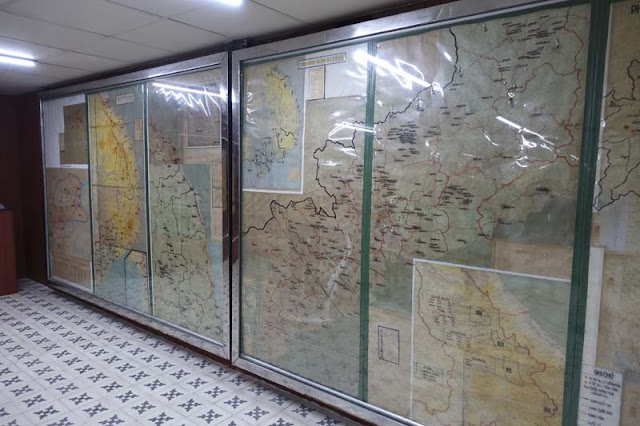Our next stop (on December 16th) was the Vietnamese port city of Phu My, located about two hours from Ho Chi Minh City (formerly called Saigon). For anyone my age, Vietnam conjures up a multitude of memories. One of my friends, a decorated tank Captain during the Vietnam War, recommended an excellent book called The Cat from Hue. Written by CBS Correspondent John Laurence, the 872-page tome takes you along on patrols with 18-year-olds fresh from Nebraska farms into the hellish environment of Vietnam’s jungles. It also documented the lives of the war correspondents like Laurence, who were greeted by the troops with the admonition “You mean you are here because you want to be? Shee-it.” The book certainly set the tone for our tour of Vietnam and Ho Chi Minh City.
 |
| Over 40 buses await the hoards of passengers departing the Celebrity Millennium. |
As usual, we had a two-hour drive into the city with a very talkative tour guide. He told us the average factory worker makes $8 a day, and his wife gets up at 5:00 am to take the kids 20 miles to a favored preschool, since without education you have no future in today’s Vietnam. Life is better now in Vietnam, but it’s still a daily struggle for most of the people.
As we crossed the bridge over the Saigon River we could see the gleaming office towers in the distance. The economy in Vietnam is very good, but most of the jobs are in the city, while most of the population lives in the rural areas meaning thousands of people commute each day on small motorcycles. The traffic, like Bangkok, is beyond description. Trying to cross a major city street on foot is suicidal, pedestrians have no right of way and the motorcycles are packed so tight they have little choice of direction.
 |
| This represents relatively light traffic on a side street in downtown Ho Chi Minh City. |
 |
| We pray these little girls have a brighter future in Vietnam than past generations. |
Our first stop was the Ton Duc Thang Museum near the river. The museum is a tribute to President Thang, a patriotic hero and fighter who took over as President after President Ho Chi Minh in 1969. The small, intimate museum features over 600 historic items, from early coins and jewelry to historic maps and paintings. Our guide mentioned that human habitation of Vietnam dates back over 4,000 years and 1,100 of those years were under the domination of various armies, from the Chinese and Genghis Kahn to the Japanese, French, Americans and now North Vietnamese in more modern times.
 |
| Spiked poles installed at low tide help thwart attack by the huge Chinese fleet. |
Always out numbered and outgunned, the Vietnamese became superb strategists on how to prolong the fighting to wear down their enemies. When Chinese armies attacked in the 13th century with hundreds of ships, the Vietnamese waited until low tide and lined the harbor with sharpened underwater poles that impaled the Chinese ships that entered at high tide. During the wars with the French and Americans, the Vietnamese built an elaborate underground tunnel system with huge storerooms, barracks, kitchens, and hospitals. Despite carpet bombing by the American B-52s, many of the tunnels held, allowing the Vietnamese to survive and escape the attacking armies.
 |
| The famous scene on April 30, 1975 as American and Vietnamese personnel tried to escape the attacking North Vietnamese troops in downtown Saigon. (Photo courtesy of Wikipedia.) |
It was disturbing to stand at the wrought iron front gates in front of the Palace thinking back to April 30, 1975 when throngs of Vietnamese who had been working for the Americas pleaded with guards to let them through so they could evacuate by the helicopters landing on the roof. He told one tear-wrenching story of a mother whose husband had already evacuated, but the mother and 5-year-old daughter were struggling to get through when the mother was trampled to death. Thankfully someone grabbed the traumatized young girl and she made it America to start a new life.
 |
| The infamous roof top bar at the Rex Hotel. |
 |
| The gray building was formerly CIA headquarters. |
As we left we passed the old Rex Hotel, whose top floor bar was the nightly habitat of foreign journalists, CIA operatives, black marketers, drug dealers, and every other sort of war time rabble. Nearby the guide pointed out an aging gray building that served as CIA headquarters during the war. If only the walls could talk.
 |
| The life of many Vietnamese hasn't changed much over the last 50 years. |
It was a quiet ride back to the ship with Meryl and I contemplating everything we’d seen, with a realization of the incredible sacrifices made by many of our peers and classmates who served in the Armed Forces during the war. It was a highly unpopular war. Most didn’t want to be there, but they felt it was their duty and they did the best they could under the circumstances. They deserved much better than the reception they got when they returned home to the U.S. And rest in peace to the thousands that never made it home.


















No comments:
Post a Comment